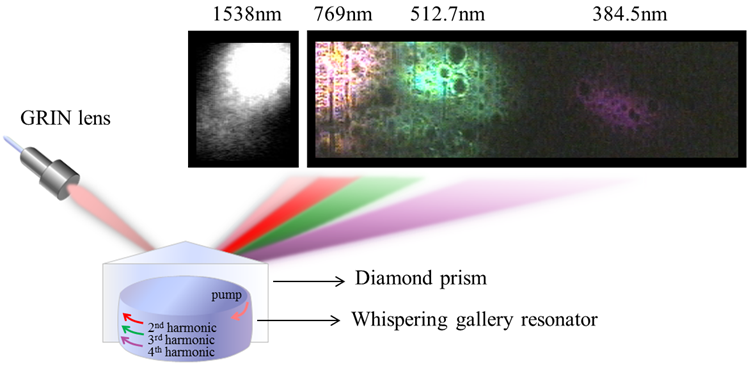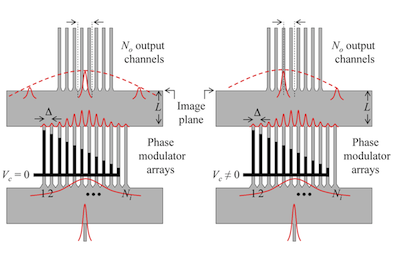Research Directions
- Terahertz/Millimeter-Wave Electronics, Optoelectronics, and Novel Materials
- Microwave Photonics and Ultrafast Electro-Optics
- Terahertz/Infrared Imaging and Spectroscopy
Research Highlights [ Summary ]
High-performance terahertz optoelectronics based on plasmonic photoconductors
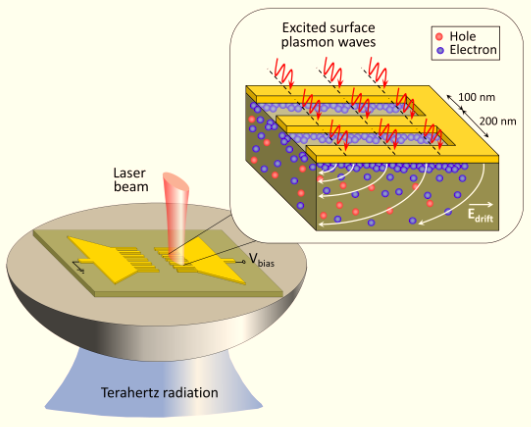
We demonstrate that use of plasmonic contact electrodes can significantly mitigate the low quantum efficiency performance of photoconductive terahertz optoelectronics. The use of plasmonic contact electrodes offers nanoscale carrier transport path lengths for the majority of photocarriers, increasing the number of collected photocarriers in a sub-picosecond time-scale and, thus, enhancing the optical-to-terahertz conversion efficiency of photoconductive terahertz emitters and the detection sensitivity of photoconductive terahertz detectors. We experimentally demonstrate 50 times higher terahertz radiation powers from a plasmonic photoconductive emitter in comparison with a similar photoconductive emitter with non-plasmonic contact electrodes, as well as 30 times higher terahertz detection sensitivities from a plasmonic photoconductive detector in comparison with a similar photoconductive detector with non-plasmonic contact electrodes. Consequently, our presented plasmonic photoconductive terahertz optoelectronics concept offers more than three orders of magnitude enhancement in the signal-to-noise ratio of time-domain and frequency-domain terahertz spectroscopy and imaging systems.
Read more at:
- C. W. Berry, N. Wang, M. R. Hashemi, M. Unlu, M. Jarrahi, "Significant Performance Enhancement in Photoconductive Terahertz Optoelectronics by Incorporating Plasmonic Contact Electrodes", Nature Communications, 4, 1622, doi: 10.1038/ncomms2638, 2013
- C. W. Berry, M. Jarrahi, "Terahertz generation using plasmonic photoconductive gratings", New Journal of Physics Focus Issue on Terahertz Plasmonics, 14, 105029, 2012
- C. W. Berry, M. Jarrahi, "Principles of impedance matching in photoconductive antennas", Journal of Infrared, Millimeter and Terahertz Waves, 33, 1182-1189, 2012
- C. W. Berry, M. Unlu, M. R. Hashemi, M. Jarrahi, "Use of Plasmonic Gratings for Enhancing the Quantum Efficiency of Photoconductive Terahertz Sources", Proc. International Conference on Infrared, Millimeter, and Terahertz Waves, Wollongong, Australia, Sep 23-28, 2012
- C. W. Berry, M. Jarrahi, "Plasmonic Photoconductive Antennas for High Power Terahertz Generation", Proc. IEEE International Antennas and Propagation Symposium, Chicago, IL, 8-14 July, 2012
- C. W. Berry, M. Jarrahi, "High-Performance Photoconductive Terahertz Sources Based on Nanoscale Contact Electrode Gratings", IEEE International Microwave Symposium Digest, Montreal, Canada, 17-22 June, 2012
Optical-Pump Terahertz-Probe Studies at Nanoscale: Extraordinary Interaction of Terahertz and Optical Waves through Metallic Nano-Slits
We analyze the unique property of periodic arrays of subwavelength metallic slits to allow extraordinary electromagnetic transmission at multiple frequency bands. Diffraction limit in periodic arrays of subwavelength metallic slits is mitigated by excitation of surface waves which assist efficient coupling of a TM-polarized incident electromagnetic wave into the TEM waveguide modes of the subwavelength slab waveguides formed by metallic slits. By investigating the geometry dependence of the electromagnetic guided modes supported by periodic arrays of subwavelength metallic slits, we present the design of a periodic array of metallic nano-slits which enables efficient interaction of terahertz and optical waves at nano-scale dimensions.
Read more at:
- B-Y. Hsieh, N. Wang, M. Jarrahi, "Toward Ultrafast Pump-Probe Measurements at the Nanoscale", Special Issue of "Optics in 2011" Optics & Photonics News, 22, 48, 2011
- B-Y. Hsieh, M. Jarrahi, "Analysis of periodic metallic nano-slits for efficient interaction of terahertz and optical waves at nano-scale dimensions", Journal of Applied Physics, 109, 084326, 2011
- B-Y. Hsieh, M. Jarrahi, "Extraordinary Interaction of Terahertz and Infrared Waves through Metallic Nano-Slits", Proc. IEEE Photonics Conference (IPC), Arlington, VA, Oct 9-13, 2011
- B-Y. Hsieh, M. Jarrahi, "Simultaneous focusing of terahertz and optical waves into nano-scale", Proc. International Conference on Infrared, Millimeter, and Terahertz Waves, , Houston, TX, Oct 2-7, 2011
- M. Jarrahi, "Extraordinary interaction of terahertz and optical waves through metallic nano-slits", Proc. URSI General Assembly and Scientific Symposium, , Istanbul, Turkey, Aug 13-20, 2011
Continuous-Wave Ultraviolet Emission through Fourth-Harmonic Generation in a Whispering-Gallery Resonator
We experimentally demonstrate continuous-wave ultraviolet emission through forth-harmonic generation in a millimeter-scale lithium niobate whispering-gallery resonator pumped with a telecommunication-compatible infrared source. The whispering-gallery resonator provides four spectral lines at ultraviolet, visible, near-infrared and infrared, which are equally spaced in frequency via the cascaded-harmonic process and span a 2-octave frequency band. Our technique relies on a variable crystal poling and high transverse order of the modes for phase-matching and a resonator quality factor to allow cascaded-harmonic generation up to the fourth-harmonic at input pump powers as low as 200mW. The compact size of the whispering gallery resonator pumped at telecommunication-compatible infrared wavelengths and the low pump power requirement make our device a promising ultraviolet light source for information storage, microscopy, and chemical analysis.
Read more at:
- J. Moore, M. Tomes, T. Carmon, M. Jarrahi, "Continuous-wave Cascaded-Harmonic Generation and Multi-Photon Raman Lasing in Lithium Niobate Whispering-Gallery Resonators", Applied Physics Letters, 99, 221111, 2011
- J. Moore, M. Tomes, T. Carmon, M. Jarrahi, "Continuous-Wave Ultraviolet Emission through Fourth-Harmonic Generation in a Whispering-Gallery Resonator", Optics Express, 19, 24139-24146, 2011
- J. Moore, M. Tomes, T. Carmon, M. Jarrahi, "Generation of Continuous-Wave UV, Visible, and Near-IR Waves in a Whispering-Gallery Resonator", Proc. Frontiers in Optics (FIO), San Jose, CA, Oct 16-20, 2011
- J. Moore, M. Tomes, T. Carmon, M. Jarrahi, "Simultaneous High-Harmonic Generation and Raman Lasing in a Lithium Niobate Whispering-Gallery Resonator", Proc. IEEE Photonics Conference (IPC), Arlington, VA, Oct 9-13, 2011
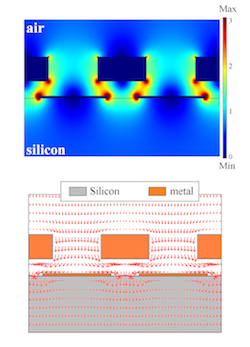
Design of reconfigurable double-layered metallic slits for terahertz beam modulation
We analyze the interaction of electromagnetic waves with double-layered subwavelength metallic slits on a dielectric substrate. This structure allows efficient transmission of an incident TM-polarized electromagnetic wave into the dielectric substrate, due to the presence of surface modes which couple the incident wave to the TEM waveguide modes supported by the subwavelength metallic slits. Our study shows that electromagnetic transmission through double-layered subwavelength metallic slits is strongly geometry dependent. Based on this observation, a terahertz modulation scheme is presented which, compared to existing terahertz modulator solutions, has the promise of significant enhancement in modulation index over a broad range of terahertz frequencies.
Read more at:
- C. W. Berry, Jeremy Moore, M. Jarrahi, "Design of Reconfigurable Metallic Slits for Terahertz Beam Modulation", Optics Express, 19, 1236-1245, 2011
- M. Jarrahi, "Broadband terahertz modulators based on reconfigurable metamaterials and their potential application in terahertz imaging", Proc. International Symposium on Electromagnetic Theory (EMTS), 640, 2010
- S. Zarei, M. Jarrahi, "Broadband terahertz modulation based on reconfigurable metallic slits", Proc. IEEE Photonics Society Winter Topicals, 30, 2010
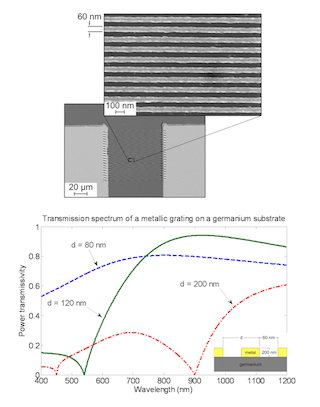
Plasmonics-enable quantum efficiency enhancement of photoconductive terahertz sources
We present plasmonically-enhanced photoconductive antenna arrays. Photoconductive antennas are one of the most commonly used devices for terahertz generation which require close contact electrode spacing for fast collection of photo-generated carriers. Normally, diffraction limit determines the minimum contact electrode spacing and the corresponding radiation efficiency at terahertz frequencies.
We experimentally demonstrate that a photoconductive antenna array with a periodic arrangement of subwavelength contact electrodes can be specifically designed to allow extraordinary transmission of an optical excitation to deep subwavelength contact electrode spacings (less than one-tenth of the wavelength). We present the fabrication and characterization of the device.
Read more at:
- C. W. Berry, M. Jarrahi, "Ultrafast Photoconductors based on Plasmonic Gratings", Proc. International Conference on Infrared, Millimeter, and Terahertz Waves, , Houston, TX, Oct 2-7, 2011
- C. W. Berry, M. Jarrahi, "Plasmonically-enhanced localization of light into photoconductive antennas", Proc. Conference of Lasers and Electro-Optics (CLEO), Paper CFI2, 2010
Demonstration of broadband terahertz modulation using reconfigurable metallic slits
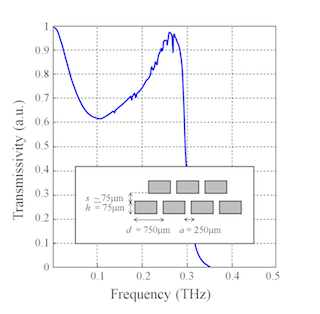
We present a terahertz modulation scheme based on reconfigurable metallic slits, which offers higher modulation depth and higher modulation bandwidth compared to the state-of-the art. The superior performance of the presented terahertz modulator is due to the unique property of subwavelength metallic slits which allows close to 100% transmission of an incident TM-polarized wave over a broad range of frequencies. By use of this modulation scheme, we demonstrate low loss terahertz modulation with 100% modulation index over a broad modulation bandwidth of 0.3THz. Initial theoretical results also promise the feasibility of a terahertz modulation depth of more than 4.5 over a broad modulation bandwidth of 2THz. Such terahertz modulators will significantly improve the image contrast and sensitivity of single-pixel terahertz imaging systems which use broadband terahertz sources and are based on compressive sensing.
Read more at:
- C. W. Berry, Jeremy Moore, M. Jarrahi, "Design of Reconfigurable Metallic Slits for Terahertz Beam Modulation", Optics Express, 19, 1236-1245, 2011
- M. Jarrahi, "Broadband terahertz modulators based on reconfigurable metamaterials and their potential application in terahertz imaging", Proc. International Symposium on Electromagnetic Theory (EMTS), 640, 2010
- S. Zarei, M. Jarrahi, "Broadband terahertz modulation based on reconfigurable metallic slits", Proc. IEEE Photonics Society Winter Topicals, 30, 2010
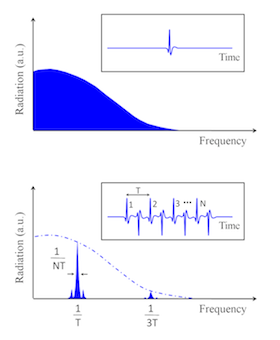
Terahertz radiation-band engineering through spatial beam-shaping
We propose a terahertz-band engineering technique based on generation of specifically designed time-domain radiation. The desired time-domain radiation is formed by combining the time-delayed outputs of an array of photoconductive antennas. We have employed this technique to generate tunable narrowband THz radiation. By using an array of identical photoconductive antennas with identical spacings, we have demonstrated a 12.5 mW output peak-power over 0.05 THz bandwidth and a tuning range of 0.65-1.4 THz. Considering the 2.5 THz bandwidth of each individual photoconductive antenna, fifty times higher power efficiency is achieved as a result of radiation band shaping.
Read more at:
- M. Jarrahi, "Terahertz radiation-band engineering through spatial beam-shaping", Photonic Technology Letters, 21, 2019620, 2009
- M. Jarrahi, T. H. Lee, "High power tunable terahertz generation based on photoconductive antenna arrays", IEEE Microwave Symposium Digest, 391, 2008
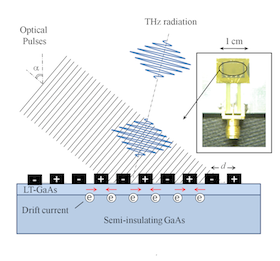
High power tunable terahertz generation based on photoconductive antenna arrays
A new scheme for a compact, continuously tunable terahertz source based on photoconductive antenna arrays is presented. Narrowband terahertz radiation is generated by superposition of time-delayed wideband radiations from an array of sub-picosecond photoconductive antennas. We demonstrate an 8 μW average power, radiation bandwidth of 0.05THz, and a tuning range of 0.65-1.4THz, through a 2.5×10mm² photoconductive antenna array prototype.
Read more at:
- M. Jarrahi, T. H. Lee, "High power tunable terahertz generation based on photoconductive antenna arrays", IEEE Microwave Symposium Digest, 391, 2008
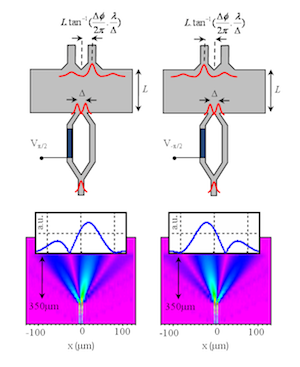
Optical switching based on high-speed phased-array optical beam steering
We present a high-speed optical switching scheme based on phased array optical beam steering, and analyze the tradeoff between the switch power efficiency, signal-to-noise-ratio, number of output channels, and switching speed. For the proof-of-concept, a two-channel optical switch has been fabricated, using a high-speed GaAs/AlGaAs multiple quantum well phase modulator. We demonstrate a beam deflection angle of 100 mRad at the fastest ever reported speed of 18 GHz, consuming 1.8 mW. A signal-to-noise ratio of 8 dB is measured at each output channel. The relatively low signal-to-noise ratio can be further improved by increasing the number of phased arrays.
Read more at:
- M. Jarrahi, R. F. W. Pease, D. A. B. Miller, T. H. Lee, "Optical switching based on high-speed phased-array optical beam steering", Applied Physics Letters 92, 014106, 2008
- M. Jarrahi, R. F. W. Pease, D. A. B. Miller, T. H. Lee, "High-speed optical beam-steering based on phase-arrayed waveguides", Journal of Vacuum Science & Technology B, 26, 2124, 2008 (also appeared in the Virtual Journal of Ultrafast Science, 8, 2009)
High-speed optical beam-steering based on phase-arrayed waveguides
Optical beam steering devices are becoming especially important because they have a wide range of applications in optical interconnects, optical switches, laser printers, optical scanners, optical memory, and data conversion systems. The majority of the reported beam-steering methods have not fulfilled the speed, efficiency, power, and cost requirements especially for telecommunication and internet applications. In this work we present a high-speed phased array optical beam steering system and demonstrate a proof-of-concept beam steering prototype, based on high-speed GaAs/AlGaAs multiple quantum well phase modulators, performing 100 mRad deflection angle at the fastest ever reported, instrument-limited deflection speed of 18GHz and power consumption of 1.8mW.
Read more at:
- M. Jarrahi, R. F. W. Pease, D. A. B. Miller, T. H. Lee, "High-speed optical beam-steering based on phase-arrayed waveguides", Journal of Vacuum Science & Technology B, 26, 2124, 2008 (also appeared in the Virtual Journal of Ultrafast Science, 8, 2009)
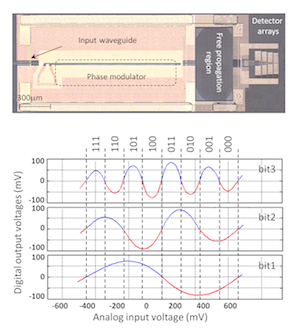
Optical spatial quantization for higher performance analog-to-digital conversion
A novel optical spatial quantized analog-to-digital conversion scheme for real-time conversion at ultra-high sampling frequencies is presented. At each sampling instant, the analog input voltage deflects an optical sampling pulse onto an array of photodetectors. The output code is derived from the output voltages of the photodetectors on which the optical beam lands. Particular benefits of the proposed architecture are significant reduction in jitter through the use of a mode-locked laser to generate the sampling pulses, high quantization bandwidth through a fully optical quantization scheme, and the system simplicity through the use of just one phase modulator and an embedded binary encoder in the binary-connected photodetector arrays. We experimentally demonstrate an 8-level quantization consuming only 7.2 pJ per quantization with 18 GHz bandwidth, projected to an estimated bandwidth of 30 GHz. Measured 8 ps full-width half-maximum photodetector output voltages promise the potential of realizing a 3-bit 125 GS/s ADC.
Read more at:
- M. Jarrahi, R. F. W. Pease, D. A. B. Miller, T. H. Lee, "Optical spatial quantization for higher performance analog-to-digital conversion", IEEE Trans. Microwave Theory and Techniques, 56, 2143, 2008
- M. Jarrahi, R. F. W. Pease, D. A. B. Miller, T. H. Lee, "Spatial quantized analog-to-digital conversion based on optical beam-steering", IEEE Journal of Lightwave Technology, 26, 2219, 2008
- M. Jarrahi, R. F. W. Pease, T. H. Lee, "Traveling wave spatial quantized analog-to-digital conversion", IEEE Microwave Symposium Digest, 225, 2007
- M. Jarrahi, D. A. B. Miller, R. F. W. Pease, T. H. Lee, "Optical spatially quantized high performance analog-to-digital conversion", Proc. Conference of Lasers and Electro-Optics (CLEO), Paper CWJ7, 2007
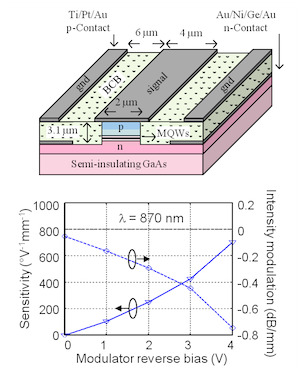
Monolithic integration of GaAs/AlGaAs phase modulator and photodetector for RF photonics
We report the design and monolithic integration of phase modulator and photodetectors for RF photonics. We demonstrate a phase modulation efficiency of 270°V¯¹mm¯¹, photodetection response time of 8ps (FWHM), and photodetection saturation power of 330mW, offering a flexible high-performance platform for RF photonics.
Based on this design, we report fabrication and testing of a traveling wave Mach-Zehnder modulator on a GaAs substrate. Operating at 870 nm wavelength, we obtained an extremely low driving voltage of 0.45 V and a high measurement-instrument-limited small-signal modulation bandwidth of 18 GHz, projected to an estimated bandwidth of 50 GHz.
Read more at:
- M. Jarrahi, T. H. Lee, D. A. B. Miller, Wideband, "low driving voltage traveling wave Mach-Zehnder modulator for RF photonics", Photonic Technology Letters 20, 517, 2008
- M. Jarrahi, D. A. B. Miller, T. H. Lee, "Monolithic integration of GaAs/AlGaAs phase modulator and photodetector for RF photonics", Proc. Optical Fiber Communication Conference and Exposition (OFC), Paper JThA36, 2008
Open Positions
We have a number of projects for which we are looking for talented postdocs, graduate and undergraduate students. Interested applicants should send a brief letter describing their research interests and experience, detailed CV, and contact information of three references to Prof. Jarrahi at mjarrahi@ee.ucla.edu.
© 2014, Electrical and Computer Engineering Department



